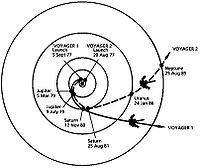
Planetary Grand Tour
Encyclopedia

Gary Flandro
Gary Flandro, PhD is an American aerospace engineer who currently holds the Boling Chair of Excellence in Space Propulsion at the University of Tennessee Space Institute. He is also the Vice President and Chief Engineer at Gloyer-Taylor Laboratories . Flandro is an 11th generation pupil of Euler...
of the Jet Propulsion Laboratory
Jet Propulsion Laboratory
Jet Propulsion Laboratory is a federally funded research and development center and NASA field center located in the San Gabriel Valley area of Los Angeles County, California, United States. The facility is headquartered in the city of Pasadena on the border of La Cañada Flintridge and Pasadena...
in the late 1960s, the Grand Tour would have exploited the alignment of Jupiter
Jupiter
Jupiter is the fifth planet from the Sun and the largest planet within the Solar System. It is a gas giant with mass one-thousandth that of the Sun but is two and a half times the mass of all the other planets in our Solar System combined. Jupiter is classified as a gas giant along with Saturn,...
, Saturn
Saturn
Saturn is the sixth planet from the Sun and the second largest planet in the Solar System, after Jupiter. Saturn is named after the Roman god Saturn, equated to the Greek Cronus , the Babylonian Ninurta and the Hindu Shani. Saturn's astronomical symbol represents the Roman god's sickle.Saturn,...
, Uranus
Uranus
Uranus is the seventh planet from the Sun. It has the third-largest planetary radius and fourth-largest planetary mass in the Solar System. It is named after the ancient Greek deity of the sky Uranus , the father of Cronus and grandfather of Zeus...
, Neptune
Neptune
Neptune is the eighth and farthest planet from the Sun in the Solar System. Named for the Roman god of the sea, it is the fourth-largest planet by diameter and the third largest by mass. Neptune is 17 times the mass of Earth and is slightly more massive than its near-twin Uranus, which is 15 times...
, and Pluto
Pluto
Pluto, formal designation 134340 Pluto, is the second-most-massive known dwarf planet in the Solar System and the tenth-most-massive body observed directly orbiting the Sun...
, an event that would occur in the late 1970s, and not recur for 176 years. A probe sent to Jupiter could use that planet as a gravitational slingshot
Gravitational slingshot
In orbital mechanics and aerospace engineering, a gravitational slingshot, gravity assist maneuver, or swing-by is the use of the relative movement and gravity of a planet or other celestial body to alter the path and speed of a spacecraft, typically in order to save propellant, time, and expense...
to extend its trajectory to planets further out in the Solar System.
The original proposed mission design had four probes. The first two, with proposed launch dates in 1976 and 1977, were to fly by Jupiter, Saturn, and Pluto. The other two, with proposed launch dates in 1979, were to fly by Jupiter, Uranus, and Neptune.
The vehicles were to have been designed with multiple redundant systems to ensure reliability over missions lasting up to 12 years.
NASA
NASA
The National Aeronautics and Space Administration is the agency of the United States government that is responsible for the nation's civilian space program and for aeronautics and aerospace research...
budget cuts eventually doomed the Grand Tour missions in 1972, as well as later proposals for a "mini grand tour". However, many elements of the Grand Tour were added to the Voyager program
Voyager program
The Voyager program is a U.S program that launched two unmanned space missions, scientific probes Voyager 1 and Voyager 2. They were launched in 1977 to take advantage of a favorable planetary alignment of the late 1970s...
. The two Voyager probes, launched in 1977, were originally meant to fly by Jupiter and Saturn. The Voyager 2
Voyager 2
The Voyager 2 spacecraft is a 722-kilogram space probe launched by NASA on August 20, 1977 to study the outer Solar System and eventually interstellar space...
mission used the fortunate alignments of the outer planets and was extended to include close flybys of both Uranus and Neptune. Voyager 2's mission has specifically come to be regarded as the "Grand Tour."
Voyager 1 could have been sent to Pluto after Saturn, but was instead sent on a trajectory which brought it close by Titan
Titan (moon)
Titan , or Saturn VI, is the largest moon of Saturn, the only natural satellite known to have a dense atmosphere, and the only object other than Earth for which clear evidence of stable bodies of surface liquid has been found....
, eliminating the Pluto flyby. Voyager 2's trajectory could not be bent to bring the probe by Pluto after the Neptune flyby in 1989.
Pluto is scheduled for exploration by the New Horizons
New Horizons
New Horizons is a NASA robotic spacecraft mission currently en route to the dwarf planet Pluto. It is expected to be the first spacecraft to fly by and study Pluto and its moons, Charon, Nix, Hydra and S/2011 P 1. Its estimated arrival date at the Pluto-Charon system is July 14th, 2015...
spacecraft set to rendezvous with the dwarf planet
Dwarf planet
A dwarf planet, as defined by the International Astronomical Union , is a celestial body orbiting the Sun that is massive enough to be spherical as a result of its own gravity but has not cleared its neighboring region of planetesimals and is not a satellite...
and its four known moons in 2015.

